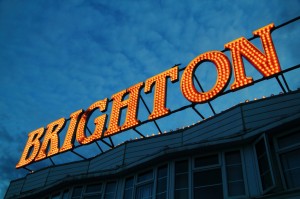 Situated in East Sussex and founded by the Saxons, Brighton sits on the southern coast of England. The city forms part of the unitary authority of Brighton and Hove, which was created in 2000 and includes Hove, Portslade and other villages in the surrounding area. Traditionally a fishing village, the community emerged as a resort town during the 18th century and became an increasingly popular tourist destination with the arrival of railways. Still a significant tourist destination, the city is England’s most populous seaside resort. It is home to a well-developed seafront with restaurants, bars, clubs, amusement arcades, sports facilities and piers overlooking the English Channel.
Situated in East Sussex and founded by the Saxons, Brighton sits on the southern coast of England. The city forms part of the unitary authority of Brighton and Hove, which was created in 2000 and includes Hove, Portslade and other villages in the surrounding area. Traditionally a fishing village, the community emerged as a resort town during the 18th century and became an increasingly popular tourist destination with the arrival of railways. Still a significant tourist destination, the city is England’s most populous seaside resort. It is home to a well-developed seafront with restaurants, bars, clubs, amusement arcades, sports facilities and piers overlooking the English Channel.
Brighton and Hove boasts a population of 273,369 according to the 2011 Census, an increase of 10.3 percent from 2001. This makes Brighton and Hove the largest unitary authority in the South East. The city covers an area of 87.54 square kilometres or 33.80 square miles. Brighton and Hove is increasingly diverse. One out of every five residents or 19.5 percent of the city’s population is from a black or minority ethnic community, according to the 2011 Census. This represents an increase of 79.7 percent compared to the 2011 Census.
Brighton was primarily a farming and fishing community until the early 18th century. Throughout the 18th century, the community emerged as a resort town beginning with the rising interest in saltwater as a curative treatment in the 1730s. Spas and indoor baths opened throughout Brighton and the surrounding area during this period. With the arrival of passenger rail service in 1841, the city evolved into a poplar day-trip destination for Londoners. Much of the city’s growth can be attributed to the patronage of the future King George IV following his first visit in 1783 as Prince Regent. During the later part of the century, Georgian terraces and landmarks such as the Royal Pavilion, the Grand Hotel, and the Palace and West piers began to define the community.
Victorian and Georgian-era attractions remain significant draws for visitors to the city in addition to Brighton’s beaches. Brighton’s tourism sector remains the city’s largest employer and a significant economic driver. The city attracts over eight million visitors annually and consistency ranks among the top 10 destinations in the UK. Over 18,000 jobs were supported by the city’s tourism sector in 2010, according to Tourism South East. The sector was also worth approximately £969.2 million in 2010.
In addition to tourism, Brighton is an important centre for commerce and the service sector. Financial and business services are an important sector and employer, with the city’s largest employer being American Express. Employing approximately 3,500 people, the company’s European headquarters are located at Amex House in Brighton since 1977. Thanks in part to the world-class University of Sussex and excellent infrastructure links to London and the surrounding region the city has a growing creative, digital and information technology sector. Retail is also a significant source of employment with major mixed leisure, retail and residential developments including The Lanes and North Laine. Asda is also a major employer with two hypermarkets in the city. In 2012, it was also estimated that about 1,500 of Gatwick Airport’s 21,000 lives in Brighton and Hove. Other major employers include Lloyds Bank and the Brighton & Hove Bus and Coach Company.

